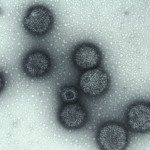Link to Pubmed [PMID] – 21550999
J. Infect. Dis. 2011 Jun;203(12):1844-9
Escherichia coli bacteremia in young infants may arise via either urinary tract infection or gut translocation (GT). E. coli GT isolates have rarely been investigated. Molecular analysis of 100 E. coli isolates recovered from bacteremic infants revealed that GT isolates had multilocus sequence types similar to those of urosepsis isolates but different prevalences of PapGII adhesin, TcpC protectin, and ibeA invasin. Compared with late-onset GT isolates, early-onset isolates were associated with significantly different rates of the conserved virulence plasmidic region common to human and avian pathogenic strains and α-hemolysin. We identified genetic determinants potentially involved in specific pathophysiological steps preceding E. coli bloodstream invasion.

